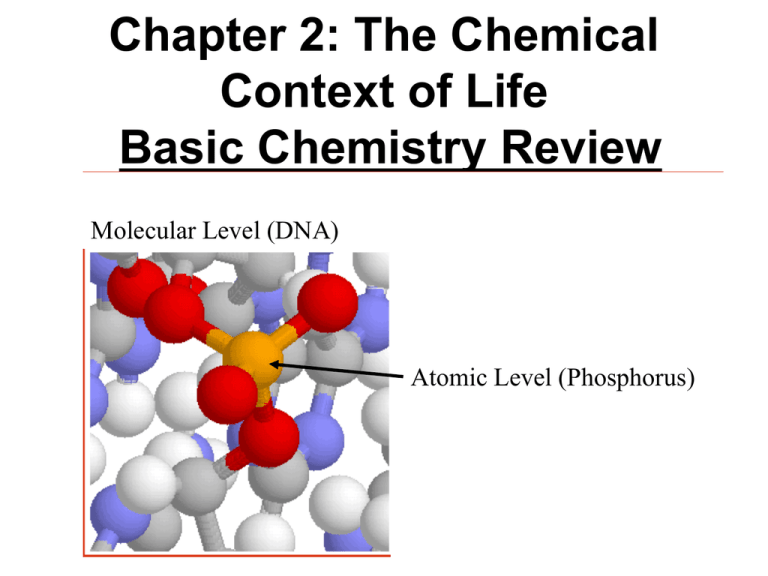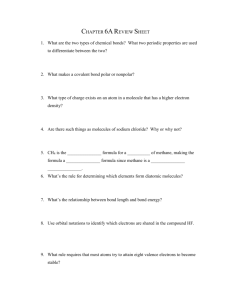Chapter 2: The Chemical Context of Life
advertisement

Chapter 2: The Chemical Context of Life Basic Chemistry Review Molecular Level (DNA) Atomic Level (Phosphorus) Nitrogen vs. No Nitrogen Element: substance that cannot be broken down into other substances by chemical reactions Enlarged thyroid gland caused by iodine deficiency. Compound: pure substance composed of 2 or more elements combined in a fixed ratio • example: NaCl • have unique properties beyond those of the combined elements glucose Atom: smallest unit of matter that retains the physical and chemical properties of its element • three subatomic particles: Particle Charge Location Mass Proton + nucleus 1.009 amu Neutron 0 nucleus 1.007 amu Electron - electron cloud 1/2000 amu Atomic number: # of protons in an atom of an element -all atoms of an element have the same atomic # -written as a subscript next to the element’s symbol -in a neutral atom, # protons = # electrons Mass number = # of protons + # of neutrons -written as a superscript next to element’s symbol -# of neutrons can vary in an element, but proton # is constant Isotopes: atoms of an element that have different # of neutrons -in nature, elements occur as mixtures of isotopes -some are RADIOACTIVE: unstable isotope where nucleus decays emitting subatomic particles and/or energy as radioactivity, causing one element to transform into another element Half-life: the time it takes for 50% of the radioactive atoms in a sample to decay Energy Levels of Electrons • ELECTRONS are the only subatomic particle involved in chemical reactions because they occupy energy levels surrounding the nucleus Potential energy: energy that matter stores because of its position or location -matter will move to the lowest state of potential energy -there are fixed potential energy states for electrons: energy levels or electron shells -electrons with lowest PE are closest to nucleus -electrons may move from one level to another and in the process they gain or lose energy Potential energy (continued): -an atom’s electron configuration determines it’s chemical behavior -chemical properties of an atom depend upon the number of valence (outermost shell) electrons Chemical Bonding *Octet Rule: atoms will share, gain, or lose electrons in order to achieve a stable electron configuration of 8 (like a noble gas) *Covalent bond: strong chemical bond between atoms formed by sharing a pair of valence electrons *Electronegativity: atom’s ability to attract and hold ELECTRONS -the more electronegative an atom, the more strongly it attracts shared electrons -examples: O = 3.5; N = 3.0; C = 2.5; H = 2.1 *Nonpolar covalent bond: covalent bond formed by an equal sharing of electrons between atoms -occurs when electronegativity of both atoms is about the same -molecules made of one element contain nonpolar covalent bonds *Polar covalent bond: unequal sharing of electrons -occurs between 2 atoms with different electronegativities -shared electrons spend more time around the more electronegative atoms *Ionic bond: bond formed by the electrostatic attraction after the complete transfer of one or more electrons from a donor atom to an acceptor -anion: negatively charged ion; has gained 1 or more electrons -cation: positively charged ion; has lost 1 or more electrons *Hydrogen bond: weak bond between a hydrogen atom covalently bonded to a more electronegative atom, and an unshared pair of electrons on an adjacent molecule -a charge attraction between oppositely charged regions of polar molecules -short-lived -numerous (make up in # what they lack in strength and duration) Chapter 3: Water and the Fitness of the Environment Water… • Life on earth probably evolved in water • Living cells are 70%-90% water • Water covers approx. ¾ of earth. • In nature, water naturally exists in all 3 states of matter: solid, liquid and gas Water is a POLAR molecule -The polarity of water molecules results in… HYDROGEN BONDING -Each water molecule can form a maximum of 4 hydrogen bonds with neighboring water molecules Properties of Water (as a result of polarity and H-bonding): 1) COHESION: molecules are held together by H bonds -contributes to upward movement of water in plants from roots to leaves Properties of Water 2) ADHESION: water sticks to other surfaces (by polarity or H bonds); can counteract gravity in plant vessels Properties of Water 3) SURFACE TENSION: measure of how difficult it is to stretch the surface of a liquid -water has greater surface tension than most liquids because at the air/water interface the surface water molecules are H-bonded to each other and to the water molecules below -causes water to “bead” -creates a “skin” on the surface Properties of Water 4) HIGH SPECIFIC HEAT (resists changes in temp) -Specific Heat: amt. of heat that must be absorbed or lost for 1 gram of a substance to change its temp by 1°C -Water’s high specific heat means that it resists temp. changes when it absorbs or releases heat *Heat is absorbed to break H-bonds; and given off when they form Properties of Water 5) HIGH HEAT OF VAPORIZATION -Heat of vaporization = amt. of heat a liquid must absorb for 1 g to be converted to gas state -for water molecules to evaporate, Hbonds must be broken, which requires heat energy ● EVAPORATIVE COOLING: after high temp. molecules have evaporated, the remaining liquid is cooler (ex: sweating) -stabilizes temp. in aquatic ecosystems -protects organisms from overheating (as 1 g of water evaporates from our skin, 539g of body cools by 1°C) The air in the shower stall is at the same temperature as the air outside, but there's less water vapor outside to condense on the skin. EVAPORATIVE COOLING HEAT OF VAPORIZATION (WHILE CHANGING STATE) SPECIFIC HEAT (WHILE WATER IS HEATING) Properties of Water 6) WATER EXPANDS WHEN IT FREEZES -because of H-bonding, water is less dense as a solid than it is as a liquid...ice floats! -since ice is less dense, it forms on the surface at first -as water freezes, it releases heat to the water below and insulates it! -Oceans and lakes don’t freeze solid!! cell Properties of Water 7) WATER IS THE SOLVENT OF LIFE -due to its polarity, water is a versatile solvent • Compounds that are HYDROPHILIC (“water loving”), are soluble in water: -ionic compounds: charged regions of polar water molecules have an electrical attraction to charged ions -polar compounds: charged regions of polar water molecules are attracted to oppositely charged regions of other polar molecules ● Compounds that are HYDROPHOBIC (“water fearing”) are insoluble in water: – Nonpolar compounds: symmetric distribution in charge, or composed of nonpolar bonds Solutions and Concentration ● Quantitative Information: -mole -molecular weight (molar mass, g/mol) -molarity: # of moles solute per liter of solution Acids, Bases, and pH ● in neutral water: [H+] = [OH-] = 10-7M ● acids increase [H+]; bases decrease [H+] ● in any solution, [H+] ● [OH-] = 1 x 10-14 ● pH = -log [H+] pH scale Acid precipitation ● rain, snow, or fog with pH less than 5.6 -sulfur oxides and nitrogen oxides in the atmosphere react with water to form acid Chapter 4: Carbon and the Molecular Diversity of Life Overview: Carbon—The Backbone of Biological Molecules ● Although cells are 70–95% water, the rest consists mostly of carbon-based compounds ● Carbon is unparalleled in its ability to form large, complex, and diverse molecules ● Proteins, DNA, carbohydrates, and other molecules that distinguish living matter are all composed of carbon compounds The Formation of Bonds with Carbon ● With four valence electrons, carbon can form four covalent bonds with a variety of atoms ● This tetravalence makes large, complex molecules possible LE 4-3 Molecular Formula Methane Ethane Ethene (ethylene) Structural Formula Ball-and-Stick Model Space-Filling Model LE 4-4 Hydrogen (valence = 1) Oxygen (valence = 2) Nitrogen (valence = 3) Carbon (valence = 4) LE 4-5 Ethane Propane Butane 2-methylpropane (commonly called isobutane) Length Branching 1-Butene Double bonds Cyclohexane Rings 2-Butene Benzene Hydrocarbons: ● Hydrocarbons are organic molecules consisting of only carbon and hydrogen (ex. fats) ● Hydrocarbons can undergo reactions that release a large amount of energy Fat droplets (stained red) A fat molecule 100 µm Mammalian adipose cells Isomers: ● Isomers are compounds with the same molecular formula but different structures and properties: – Structural isomers have different covalent arrangements of their atoms – Geometric isomers have the same covalent arrangements but differ in spatial arrangements – Enantiomers are isomers that are mirror images of each other LE 4-7 Structural isomers differ in covalent partners, as shown in this example of two isomers of pentane. cis isomer: The two Xs are on the same side. trans isomer: The two Xs are on opposite sides. Geometric isomers differ in arrangement about a double bond. In these diagrams, X represents an atom or group of atoms attached to a double-bonded carbon. L isomer D isomer Enantiomers differ in spatial arrangement around an asymmetric carbon, resulting in molecules that are mirror images, like left and right hands. The two isomers are designated the L and D isomers from the Latin for left and right (levo and dextro). Enantiomers cannot be superimposed on each other. The Functional Groups Most Important in the Chemistry of Life: ● Functional groups are the components of organic molecules that are most commonly involved in chemical reactions ● The number and arrangement of functional groups give each molecule its unique properties ● The six functional groups that are most important in the chemistry of life: – Hydroxyl group – Carbonyl group – Carboxyl group – Amino group – Sulfhydryl group – Phosphate group **check your chart!!! LE 4-10aa STRUCTURE (may be written HO—) Ethanol, the alcohol present in alcoholic beverages NAME OF COMPOUNDS Alcohols (their specific names usually end in -ol) FUNCTIONAL PROPERTIES Is polar as a result of the electronegative oxygen atom drawing electrons toward itself. Attracts water molecules, helping dissolve organic compounds such as sugars (see Figure 5.3). LE 4-10ab Acetone, the simplest ketone STRUCTURE EXAMPLE Acetone, the simplest ketone NAME OF COMPOUNDS Propanal, an aldehyde Ketones if the carbonyl group is within a carbon skeleton FUNCTIONAL PROPERTIES Aldehydes if the carbonyl group is at the end of the carbon skeleton A ketone and an aldehyde may be structural isomers with different properties, as is the case for acetone and propanal. LE 4-10ac STRUCTURE EXAMPLE Acetic acid, which gives vinegar its sour taste NAME OF COMPOUNDS Carboxylic acids, or organic acids FUNCTIONAL PROPERTIES Has acidic properties because it is a source of hydrogen ions. The covalent bond between oxygen and hydrogen is so polar that hydrogen ions (H+) tend to dissociate reversibly; for example, Acetic acid Acetate ion In cells, found in the ionic form, which is called a carboxylate group. LE 4-10ba STRUCTURE EXAMPLE Glycine Because it also has a carboxyl group, glycine is both an amine and a carboxylic acid; compounds with both groups are called amino acids. NAME OF COMPOUNDS Amine FUNCTIONAL PROPERTIES Acts as a base; can pick up a proton from the surrounding solution: (nonionized) (ionized) Ionized, with a charge of 1+, under cellular conditions LE 4-10bb STRUCTURE EXAMPLE (may be written HS—) Ethanethiol NAME OF COMPOUNDS Thiols FUNCTIONAL PROPERTIES Two sulfhydryl groups can interact to help stabilize protein structure (see Figure 5.20). LE 4-10bc STRUCTURE EXAMPLE Glycerol phosphate NAME OF COMPOUNDS Organic phosphates FUNCTIONAL PROPERTIES Makes the molecule of which it is a part an anion (negatively charged ion). Can transfer energy between organic molecules. ATP: An Important Source of Energy for Cellular Processes ● One phosphate molecule, adenosine triphosphate (ATP), is the primary energytransferring molecule in the cell ● ATP consists of an organic molecule called adenosine attached to a string of three phosphate groups







